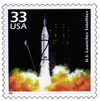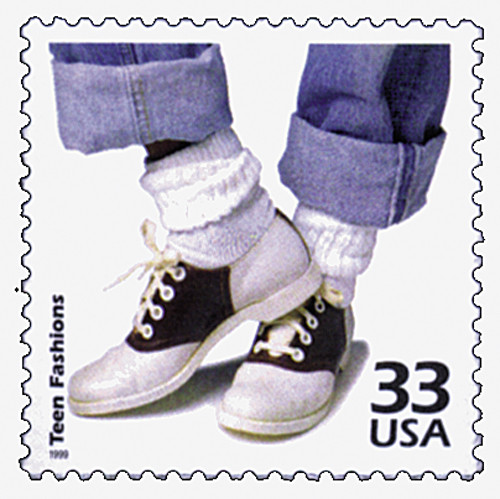
# 3187d - 1999 33c Celebrate the Century - 1950s: U.S. Launches Satellites
US #3187d
1999 US Launches Satellites – Celebrate the Century (1950s)
• Part of the sixth sheet in the Celebrate the Century stamp series issued from 1998-2000
• Commemorates first US satellites launched into space
• Includes text on the back with historical details
Stamp Category: Commemorative
Series: Celebrate the Century
Value: 32¢ First Class Mail Rate
First Day of Issue: May 26, 1999
First Day City: Springfield, Massachusetts
Quantity Issued: 188,000,000
Printed by: Ashton Potter (USA) Ltd.
Printing Method: Offset, Intaglio
Format: Panes of 15
Perforations: 11.5
Tagging: Block Tagging
Why the stamp was issued: To honor Explorer 1 and Vanguard 1, the United State’s first two satellites launched into space by NASA.
About the stamp design: Pictures artwork by Dean Ellis of the Jupiter-C rocket with Explorer I on top. Includes the following text on the back: “The first successful US Earth satellite, Explorer 1, was launched January 31, 1958. The second, Vanguard 1, was launched March 17, 1958. The National Aeronautics and Space Administration (NASA) was formally established October 1, 1958.”
First Day City: The First Day of Issue Ceremony was held at the Civic Center in Springfield, Massachusetts, the hometown of Dr. Seuss.
About the Celebrate the Century series: The USPS launched the Celebrate the Century series in 1998 to mark the end of the 20th century and herald the arrival of the 21st. The series includes 10 sheets of 15 stamps (150 in total), with each honoring important moments from a different decade (1900s, 10s, 20s, 30s, 40s, 50s, 60s, 70s, 80s, and 90s). At the time of completion, it was the longest and most ambitious commemorative stamp series in US history.
History the stamp represents: After World War II, the United States and the Soviet Union struggled to stay one step ahead of each other in space exploration. Substantial advancements were made by both countries during this time, but Russia was first to launch an artificial satellite, much to America’s chagrin.
In October 1957, the Soviets sent Sputnik I into orbit around the Earth. The Soviets sent up a second satellite, Sputnik II, the next month. This craft carried a dog named Laika, the first animal to be sent into space.
Explorer I became the first satellite launched by the US on January 31, 1958. Vanguard I was the second, released March 17, 1958. These satellites were smaller than the Sputniks, because American launch vehicles were not as powerful as those used by the Soviet Union. In 1959, Soviet Premier Nikita Khrushchev commented, “You send up oranges while we send up tons.”
The National Aeronautics and Space Administration “NASA” took control of the program in 1958. Over the next few years, each nation continued to send up unmanned spacecraft, including meteorological units and lunar probes. The first communications satellite in flight was America’s Project Score in December 1958. In February 1959, the first weather satellite, Vanguard II, transmitted pictures of clouds back to earth.
US #3187d
1999 US Launches Satellites – Celebrate the Century (1950s)
• Part of the sixth sheet in the Celebrate the Century stamp series issued from 1998-2000
• Commemorates first US satellites launched into space
• Includes text on the back with historical details
Stamp Category: Commemorative
Series: Celebrate the Century
Value: 32¢ First Class Mail Rate
First Day of Issue: May 26, 1999
First Day City: Springfield, Massachusetts
Quantity Issued: 188,000,000
Printed by: Ashton Potter (USA) Ltd.
Printing Method: Offset, Intaglio
Format: Panes of 15
Perforations: 11.5
Tagging: Block Tagging
Why the stamp was issued: To honor Explorer 1 and Vanguard 1, the United State’s first two satellites launched into space by NASA.
About the stamp design: Pictures artwork by Dean Ellis of the Jupiter-C rocket with Explorer I on top. Includes the following text on the back: “The first successful US Earth satellite, Explorer 1, was launched January 31, 1958. The second, Vanguard 1, was launched March 17, 1958. The National Aeronautics and Space Administration (NASA) was formally established October 1, 1958.”
First Day City: The First Day of Issue Ceremony was held at the Civic Center in Springfield, Massachusetts, the hometown of Dr. Seuss.
About the Celebrate the Century series: The USPS launched the Celebrate the Century series in 1998 to mark the end of the 20th century and herald the arrival of the 21st. The series includes 10 sheets of 15 stamps (150 in total), with each honoring important moments from a different decade (1900s, 10s, 20s, 30s, 40s, 50s, 60s, 70s, 80s, and 90s). At the time of completion, it was the longest and most ambitious commemorative stamp series in US history.
History the stamp represents: After World War II, the United States and the Soviet Union struggled to stay one step ahead of each other in space exploration. Substantial advancements were made by both countries during this time, but Russia was first to launch an artificial satellite, much to America’s chagrin.
In October 1957, the Soviets sent Sputnik I into orbit around the Earth. The Soviets sent up a second satellite, Sputnik II, the next month. This craft carried a dog named Laika, the first animal to be sent into space.
Explorer I became the first satellite launched by the US on January 31, 1958. Vanguard I was the second, released March 17, 1958. These satellites were smaller than the Sputniks, because American launch vehicles were not as powerful as those used by the Soviet Union. In 1959, Soviet Premier Nikita Khrushchev commented, “You send up oranges while we send up tons.”
The National Aeronautics and Space Administration “NASA” took control of the program in 1958. Over the next few years, each nation continued to send up unmanned spacecraft, including meteorological units and lunar probes. The first communications satellite in flight was America’s Project Score in December 1958. In February 1959, the first weather satellite, Vanguard II, transmitted pictures of clouds back to earth.













